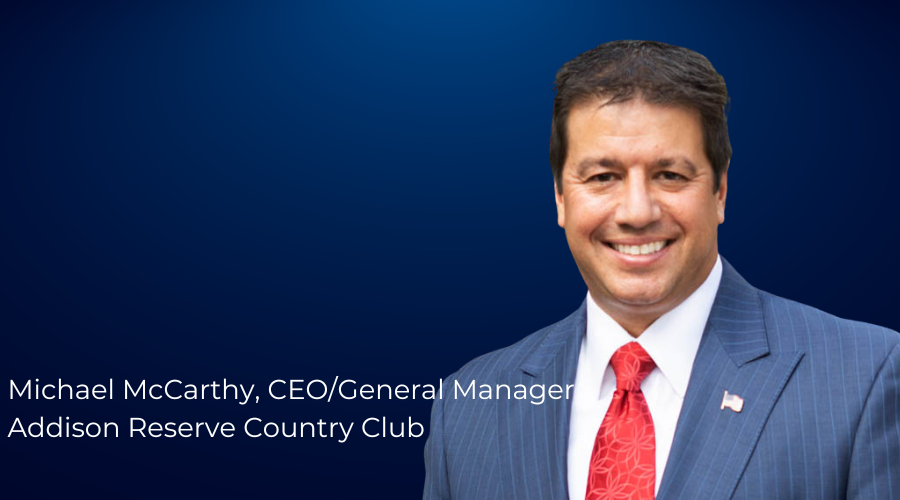The Next Chapter in Club Governance: An Interview with Michael McCarthy
- August 30, 2023
- Governance, Insight, Private Clubs, Leadership

Michael McCarthy is the CEO/General Manager of Addison Reserve Country Club in Delray Beach, Florida, a position he has held for 17 years. In 2007, Michael served on an Advisory Committee to help develop the Club Governance Model (Model) for the Club Management Association of America (CMAA). Designated the Standard of Excellence by CMAA, the Model began to be adopted by clubs across the country, albeit slowly. Sixteen years later, Michael was again asked to revisit club governance principles and practices – this time by serving on a committee to write a Club Governance Handbook (Handbook) for the National Club Association (NCA) and CMAA. “Private Club Governance: A Handbook of Principles and Best Practices” was released in August 2023 and is available to both CMAA and NCA members.
We caught up with Michael to reflect on the journey from the 2007 Model to the 2023 Handbook and to hear his thoughts about the next chapter for club governance.
GGA: Michael, you have been at the forefront of club governance for over two decades, you were one of the first General Managers to be given the title of CEO, you were on the advisory team that developed the Club Governance Model, and most recently on the committee that prepared the Governance Handbook. What is it about club governance that deserves so much of your attention?
McCarthy: I started working in private clubs in 1988. At the time, the majority of clubs held onto antiquated traditions of governance. They were run by Boards of Directors, officers, or committees with more of a focus on collegiality than on efficiency. There was almost hostility to operating clubs like a business. I was fortunate to have seen in business how important it is to distinguish between governing at a strategic level and managing at an operating level. So, I brought that mentality to the clubs I worked with and was fortunate to have open-minded boards that saw the importance of clarifying the roles of the board and the GM.
GGA Partners: So, what do you say to members who want to be in a club and not a “business?”
McCarthy: That implies we are sacrificing collegiality to gain efficiency. Far from it. Our mission at Addison Reserve is “Excellence is our Standard.” While our members expect us to honor the mission, they also expect us to be good stewards. They are happy to see us employ proven business practices in serving them. To do otherwise is to invite members to distrust their leaders – both the board and management.
GGA Partners: You mentioned the need to distinguish between governing and managing. Why is that important at a club?
McCarthy: Boards at private clubs comprise men and women who are skilled in their professions and who have very successful careers. However, their expertise may not translate to managing a large, complex private club. That job is best left to a competent GM who is given the authority and the resources to run the club efficiently and effectively. The board continues to be responsible for setting the strategic direction of the club and for holding the GM accountable for aligning operations with the strategy. Fulfilling that responsibility calls for board members who understand that they are governors and not managers.
GGA Partners: How do they develop that understanding?
McCarthy: Start with well-documented board policies that describe the club’s governance model, the expectations of individual board members, the delegation of the authority to the GM, and the roles of the board, its officers, the advisory committees, and the GM. Ensure that the orientation of new board members includes a detailed review of board policies. Soon after the election of new board members and officers, conduct a board retreat that includes a training session to reinforce the principles and best practices of good governance.
GGA Partners: Speaking of governance models, you have observed the trend in club governance over the past two decades. Where do you see progress to date; what do you see as the next chapter; and how optimistic are you for future progress? For example, the GM/COO model was introduced more than 20 years ago and has gradually become the norm among clubs. You have held the title CEO for 17 years. Do you see the GM/COO model giving way to a GM/CEO model?
McCarthy: Although I would like it, I don’t see it happening any time soon. Remember, it took time for clubs to accept the GM as COO, and even today, many clubs have a GM/COO while their bylaws name the President as CEO. This is a vestige of the past when boards and Presidents were involved in operations. In most of these clubs, the GM/COO has operational responsibility. If that’s the case, give the GM the title of CEO, or at least remove the CEO title from the President.
GGA Partners: And finally, share your thoughts on the future of club governance.
McCarthy: As you know, I was recently involved in the development of a Club Governance Handbook that was jointly sponsored by NCA and CMAA. I see the Handbook as ushering in the next chapter for Club Governance. It contains an integrated Framework which pulls together the principles and best practices of club governance. Acting on the recommendations in the Handbook may be a challenge to clubs that have trouble emerging from the status quo, but those that take to heart the Handbook’s instruction will clearly benefit. CMAA and NCA seek to encourage General Managers to appreciate the importance of proper club governance and embrace the principles in the Governance Framework. Finally, we General Managers who have traveled the road from antiquated club governance models to the Handbook must mentor and coach the next generation of leaders to preserve the standards set in the Handbook.



